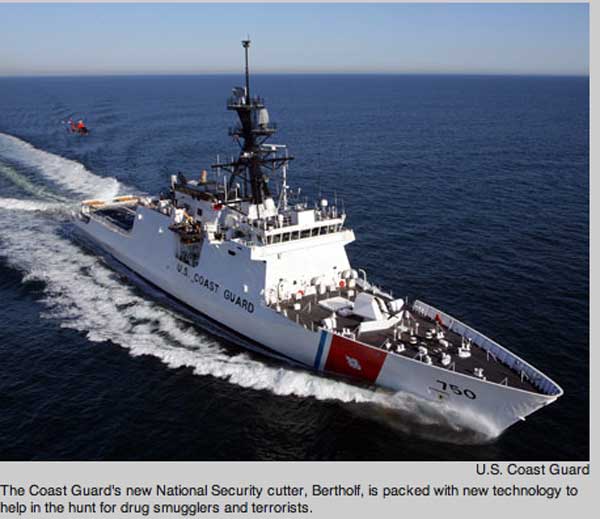By James Jay Carafano
08/02/2011 – America’s Navy and Coast Guard have always partnered to protect the nation’s sovereignty. The navy projects power. The Coast Guard policies the seas. The Coast Guard has served the nation well because the nation always gave it the right ships to do the job.
In the 1930s, despite being in the grips of the Depression, Congress authorized the US Coast Guard to build a new fleet of high-endurance cutters—ships that could sail deep into the open sea and remain there for extended periods in any weather. A strong motivation for creating the “Treasury Class” (named after former secretaries of the treasury) came from the emergence of trans-ocean air travel. Coast Guard cutters were needed to provide floating navigation stations to keep the planes on course, as well as conduct deep search and rescue. When war came the cutters found themselves fulfilling all kinds of roles including dangerous convoy escort duty. The ships proved so adept at handling the many missions assigned that they lasted for 40 years.
The next generation of high-endurance cutters, the “Hamilton Class” emerged to meet another new set of challenges, the international recognition of the exclusive economic zone, the territory that extends from the coast out to 200 nautical miles, an area in which a country enjoys special rights for the use of maritime resources. This was particularly vital for the United States for issues like fisheries. Stocks in the remote Bearing Straits, for example, account for about half of US commercial fishing revenues. Like its predecessors, the Hamilton Class also had to adapt to meet a range of unanticipated missions from the Cuban boat lift to Hurricane Katrina. This generation of ship also served the nation for over forty years—and is still at sea.
Now, it is time for a new class of ships—called the National Security Cutter. The service is following a proven tradition. Build ships that meet today’s needs. Build them to be flexible enough to accomplish many missions. Build them to last.
While the early history of the National Security Cutter was marred in controversy, arguably the Coast Guard has gotten beyond those problems. Three have already been built. The contract for the fourth cutter will be a “fixed” cost.
If the Office of Management and Budget in the White House has its way, however, they’d stop the Coast Guard from buying any more ships as a “cost-savings” measure. That makes no sense and its no option. The Hamilton class cutters were built for the “Cold War” and are wearing out. At today’s construction costs, outfitting a new Hamilton class would cost as much as a National Security Cutter. Furthermore, there is no other class of ship in the Coast Guard fleet that can handle the deepwater missions.
 (Credit: http://www.foxnews.com/story/0,2933,376522,00.html)
(Credit: http://www.foxnews.com/story/0,2933,376522,00.html)
The National Security Cutter also brings new meaning to the term “high-endurance.” It can stay on station longer than any other ship in its class. That means the US can have an enduring presence at sea. Ships can stalk pirates and drug runners. They can stand station against illegal migrant flows. They can act as stand-off headquarters to manage disasters at sea like the Deepwater Horizon platform explosion or a landward catastrophe such as New Orleans after Katrina. Most importantly, they can persistently patrol US maritime resources from fisheries to oil platforms.
The National Security Cutter’s capability really matters. Presence at sea is what ensures the sovereignty of American territory at sea. Sacrificing capability means sacrificing sovereignty.
Abandoning the National Security Cutter as a budget-cutting drill makes about as much sense as dispensing with a security alarm, putting up “no trespassing” sign and telling yourself you are more safe at less cost.
This piece originally appeared in The Washington Examiner August 1, 2011
http://washingtonexaminer.com/opinion/columnists/2011/07/sacrificing-americas-sovereignty-sea
For a discussion of the role of the National Security Cutter as a Chaos Management System see https://www.sldinfo.com/?p=10225.
To read “From the bridge of the Berthof,” see https://www.sldinfo.com/?p=20523, and to read about making USCG assets unaffordable, see https://www.sldinfo.com/?p=21079.


